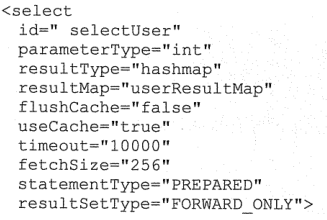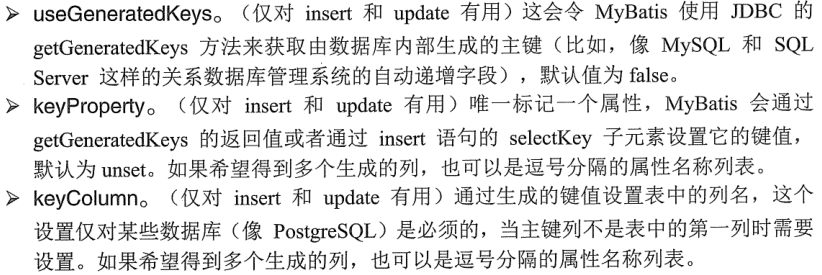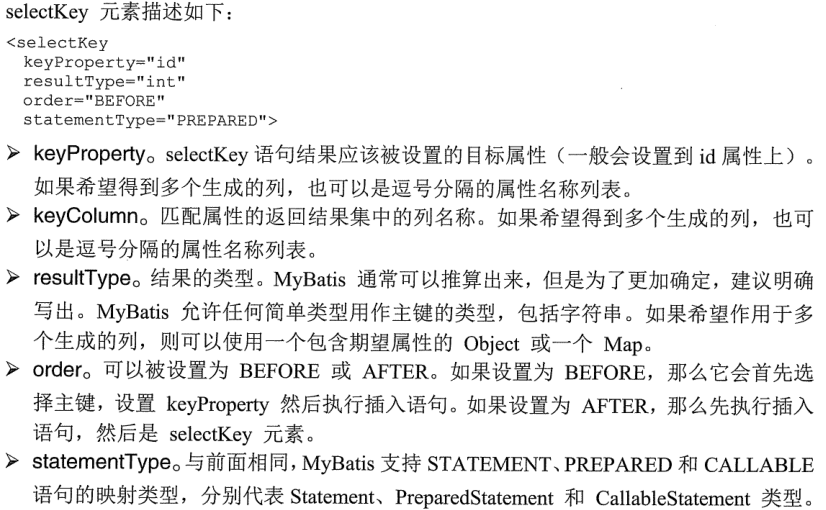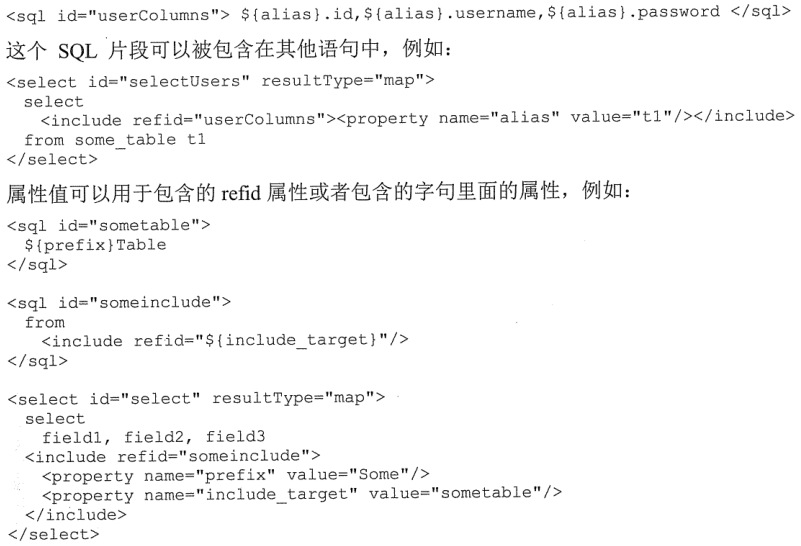1、mapper配置文件常用的元素

parameterMap已经废弃,老式风格的参数映射。
2、select元素
映射查询语句。#{...}用于预处理语句参数,通过JDBC,这样一个参数在SQL中会由一个“?”来标识,并被传递到一个新的的预处理语句中。

select元素的属性描述如下:


3、insert、update、delete
映射DML语句。与select的配置十分相似。

配置属性除了大部分与select的一致外,特有的部分如下:

如果某些数据库支持生成主键值,且驱动支持获取insert后返回的主键值,则可以设置useGeneratedKeys=“true”,keyProperty=“id”。(id是随意的,主要用来接收返回的主键值)。
对于不支持自动生成类型的数据库(如oracle)或JDBC驱动不支持,Mybatis还可以通过以下方式生成主键:

上面的示例中,selectKey元素将会先运行,通过查询SEQUENCE序列,得到的序列值会设置到id上。

4、sql
用来定义可重用的SQL代码段。可以包含在其他语句中,也可以被静态地(在加载参数时)参数化。

5、Parameters
即parameterType。

或者

6、ResultMaps
从结果集中取出的数据转换成开发者所需要的对象。

1》或者转换成我们的POJO。
<select id="selectAllUser" resultType="com.lfy.bean.User"> select * from t_user </select>
当POJO,即我们的Java Bean的属性字段与数据库的字段不一致时,需要进行转换(也可以在sql语句中给字段起别名):
<resultMap id="userResultMap" type="com.lfy.bean.User"> <!--使用id属性指定主键字段--> <id property="id" column="user_id"/> <!--使用result属性匹配普通字段--> <result property="name" column="user_name"/> <result property="sex" column="user_sex"/> </resultMap>

2》当表间发生关联,Java Bean中嵌套这另外一个Java Bean时。
以下是1对1关系,一个学生只对应一个班级,即Student中只有一个Clazz属性。
<!-- 映射学生对象的resultMap --> <resultMap id="studentResultMap" type="com.lfy.bean.Student"> <id property="id" column="id" /> <result property="name" column="name"/> <result property="sex" column="sex"/> <result property="age" column="age"/> <!-- 关联映射 --> <association property="clazz" column="clazz_id" javaType="com.lfy.bean.Clazz" select="selectClazzWithId"/> </resultMap> <!-- 根据班级id查询班级 --> <select id="selectClazzWithId" resultType="com.lfy.bean.Clazz"> SELECT * FROM TB_CLAZZ where id = #{id} </select> <!-- 查询所有学生信息 --> <select id="selectStudent" resultMap="studentResultMap"> SELECT * FROM TB_STUDENT </select>

(PS:如果是关联查询,也可以在resultMap中直接将关联表的字段映射到内嵌“内前对象”的对应字段上,如多表关联查询及Java bean中组合了其他bean)
<association property="teacher" javaType="com.lfy.bean.Teacher"> <id property="id" column="t_id"/> <result property="name" column="t_name"/> </association>
反过来,查所有班级,并查询出各班级的所有学生,将会是1对多的关系,即Clazz中有一个List<Student>属性。
<!-- 映射班级对象的resultMap --> <resultMap id="clazzResultMap" type="com.lfy.bean.Clazz"> <id property="id" column="id" /> <result property="code" column="code"/> <!-- 班级的学生属性,因为一个班级有多个学生,所以该属性是一个集合 --> <collection property="students" javaType="ArrayList" column="id" ofType="com.lfy.bean.Student" select="selectStudentWithId"/> </resultMap> <!-- 根据班级id查询学生 --> <select id="selectStudentWithId" resultType="com.lfy.bean.Student"> SELECT * FROM TB_STUDENT where clazz_id = #{id} </select> <!-- 查询所有班级信息 --> <select id="selectClazz" resultMap="clazzResultMap"> SELECT * FROM TB_CLAZZ </select>
